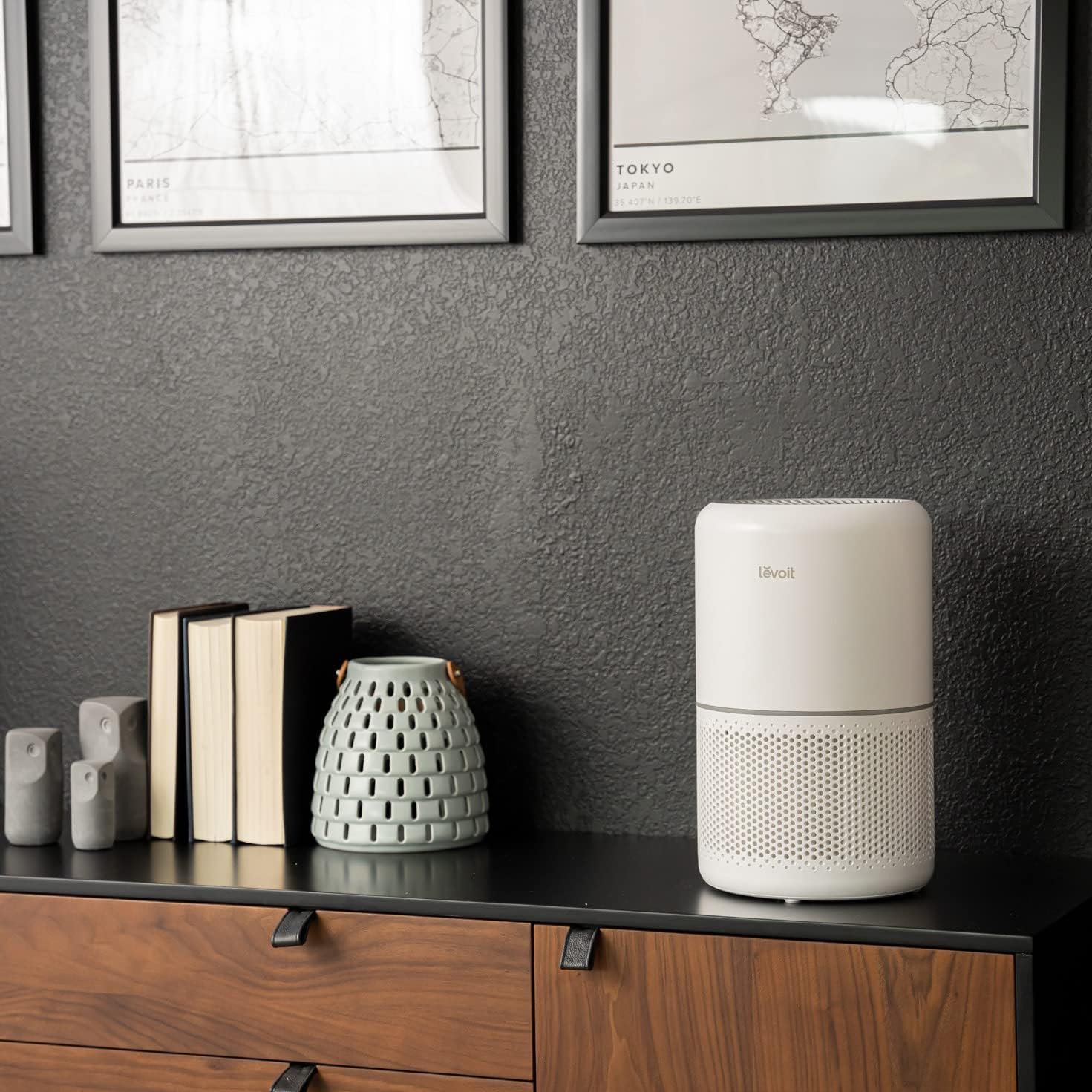Home>Furniture & Design>Outdoor Furniture>How To Improve Outdoor Air Quality


Outdoor Furniture
How To Improve Outdoor Air Quality
Published: January 14, 2024
Learn how to improve outdoor air quality with the right outdoor furniture and design. Enhance your outdoor space for a healthier environment.
(Many of the links in this article redirect to a specific reviewed product. Your purchase of these products through affiliate links helps to generate commission for Storables.com, at no extra cost. Learn more)
Introduction
Outdoor air quality plays a pivotal role in the overall well-being of communities and the environment. The quality of the air we breathe directly impacts our health, the vitality of ecosystems, and the preservation of natural resources. In recent years, the detrimental effects of outdoor air pollution have gained significant attention, prompting individuals, communities, and governments to take proactive measures to mitigate its impact.
Understanding the complexities of outdoor air pollution is crucial in formulating effective strategies to improve air quality. By identifying the sources of pollution and comprehending its far-reaching effects, we can implement targeted solutions to safeguard the environment and public health. This article delves into the various facets of outdoor air pollution, its sources, effects on health, and practical tips for enhancing outdoor air quality.
Let's embark on a journey to unravel the intricacies of outdoor air pollution and explore actionable steps to foster a cleaner and healthier outdoor environment.
Key Takeaways:
- Outdoor air pollution, caused by human activities and natural events, can harm our health and the environment. By reducing vehicle and industrial emissions, planting trees, and promoting sustainable practices, we can work together to improve outdoor air quality.
- Breathing clean air is essential for our well-being. We can help improve outdoor air quality by advocating for responsible waste management, supporting clean technologies, and raising awareness about the impact of outdoor burning.
Understanding Outdoor Air Pollution
Outdoor air pollution refers to the presence of harmful substances in the air, resulting from natural processes and human activities. These pollutants can encompass a wide array of compounds, including particulate matter, nitrogen oxides, sulfur dioxide, carbon monoxide, volatile organic compounds, and ozone. While natural sources such as volcanic eruptions and wildfires contribute to outdoor air pollution, human activities, particularly industrial processes, transportation, and energy production, are the primary drivers of elevated pollution levels.
One of the key factors contributing to outdoor air pollution is the combustion of fossil fuels. Emissions from vehicles, power plants, and industrial facilities release copious amounts of pollutants into the atmosphere, leading to the formation of smog and harmful particulate matter. Additionally, agricultural practices, waste incineration, and deforestation also contribute significantly to outdoor air pollution.
It is essential to recognize that outdoor air pollution is not confined by geographical boundaries. Pollutants can travel vast distances, impacting regions far from their original sources. This underscores the interconnectedness of global air quality and the necessity for collaborative efforts to address this pervasive issue.
Furthermore, outdoor air pollution is not solely an environmental concern; it poses a substantial threat to public health. Prolonged exposure to polluted air can exacerbate respiratory conditions, such as asthma and chronic obstructive pulmonary disease, and increase the risk of cardiovascular diseases. Vulnerable populations, including children, the elderly, and individuals with pre-existing health conditions, are particularly susceptible to the adverse effects of outdoor air pollution.
By comprehending the multifaceted nature of outdoor air pollution, we can develop targeted interventions to mitigate its impact. Through concerted efforts to reduce emissions and implement sustainable practices, we can work towards fostering a cleaner and healthier outdoor environment for current and future generations.
Sources of Outdoor Air Pollution
The sources of outdoor air pollution are diverse and encompass a wide range of human activities and natural phenomena. Understanding these sources is crucial in formulating effective strategies to mitigate pollution and improve air quality.
1. Transportation: Emissions from vehicles, including cars, trucks, and public transportation, constitute a significant source of outdoor air pollution. The combustion of fossil fuels in internal combustion engines releases pollutants such as nitrogen oxides, carbon monoxide, and particulate matter into the atmosphere, contributing to poor air quality, especially in urban areas with high traffic density.
2. Industrial Activities: Industrial processes, including manufacturing, power generation, and construction, are major contributors to outdoor air pollution. Emissions from factories, power plants, and construction sites release a myriad of pollutants, including sulfur dioxide, volatile organic compounds (VOCs), and hazardous airborne particles, significantly impacting local and regional air quality.
3. Agricultural Practices: Agricultural activities, such as livestock farming and crop cultivation, can release pollutants into the air. Livestock farming, in particular, generates ammonia and methane emissions, while agricultural burning and the use of chemical fertilizers and pesticides contribute to air pollution, affecting both rural and urban areas.
4. Waste Management: Improper waste disposal and open burning of waste materials release harmful pollutants into the atmosphere. Landfills, incineration facilities, and open burning of trash emit a range of pollutants, including dioxins, furans, and greenhouse gases, posing environmental and public health risks.
5. Deforestation and Land Use Changes: The clearing of forests and land use changes release significant amounts of particulate matter and carbon dioxide into the air. Deforestation not only diminishes the natural capacity to absorb pollutants but also contributes to the release of stored carbon, exacerbating air quality issues.
6. Natural Events: While human activities are predominant sources of outdoor air pollution, natural events such as wildfires, volcanic eruptions, and dust storms can also release substantial amounts of pollutants into the atmosphere, impacting air quality on regional and global scales.
Understanding the diverse sources of outdoor air pollution is essential in devising comprehensive strategies to address this pervasive issue. By targeting specific emission sources and implementing sustainable practices, we can work towards mitigating pollution and safeguarding the quality of the air we breathe.
Effects of Outdoor Air Pollution on Health
Outdoor air pollution poses significant risks to human health, with a myriad of adverse effects that can manifest in various physiological systems. Prolonged exposure to polluted air is associated with a range of health complications, impacting respiratory, cardiovascular, and overall well-being.
1. Respiratory Health: Inhalation of airborne pollutants can lead to respiratory issues, exacerbate pre-existing conditions, and impair lung function. Particulate matter, nitrogen oxides, and sulfur dioxide can cause respiratory inflammation, aggravate asthma, and increase the risk of respiratory infections. Long-term exposure to air pollution is linked to the development of chronic respiratory diseases, such as chronic obstructive pulmonary disease (COPD) and bronchitis.
2. Cardiovascular Health: Outdoor air pollution has profound effects on cardiovascular health, contributing to an increased risk of heart disease, stroke, and cardiovascular mortality. Fine particulate matter can enter the bloodstream, triggering systemic inflammation, oxidative stress, and endothelial dysfunction, ultimately leading to cardiovascular complications. Additionally, air pollution can elevate blood pressure and promote the progression of atherosclerosis, posing grave risks to cardiovascular well-being.
3. Neurological and Developmental Impacts: Emerging research suggests that air pollution may have adverse effects on neurological health and cognitive function. Prenatal exposure to air pollutants is associated with adverse birth outcomes and developmental issues in children. Furthermore, air pollution has been linked to neuroinflammation, cognitive decline, and an increased risk of neurodegenerative diseases in adults, underscoring the far-reaching impact of outdoor air pollution on neurological well-being.
4. Systemic Health Effects: Beyond respiratory and cardiovascular implications, outdoor air pollution can exert systemic effects on overall health. Exposure to pollutants is associated with increased inflammation, oxidative stress, and immune system dysregulation, potentially contributing to a spectrum of health challenges, including metabolic disorders, compromised immune function, and systemic inflammation-related conditions.
Vulnerable populations, including children, the elderly, individuals with pre-existing health conditions, and socioeconomically disadvantaged communities, are disproportionately affected by the health impacts of outdoor air pollution. Addressing these disparities and implementing measures to reduce pollution levels is paramount in safeguarding public health and promoting environmental justice.
By recognizing the intricate relationship between outdoor air pollution and human health, we can advocate for policies and initiatives aimed at reducing emissions, improving air quality standards, and protecting the well-being of communities worldwide.
Tips for Improving Outdoor Air Quality
Enhancing outdoor air quality requires a multifaceted approach that addresses various sources of pollution and promotes sustainable practices. By implementing targeted strategies, individuals, communities, and policymakers can contribute to mitigating air pollution and fostering a healthier outdoor environment. Here are actionable tips for improving outdoor air quality:
- Planting Trees and Vegetation: Green spaces and vegetation play a crucial role in improving air quality by absorbing pollutants and releasing oxygen. Planting trees and creating urban greenery not only enhances the aesthetic appeal of communities but also mitigates air pollution by sequestering carbon dioxide, reducing ambient temperatures, and filtering airborne particles.
- Reducing Vehicle Emissions: Encouraging the use of public transportation, carpooling, cycling, and walking can help reduce vehicular emissions, alleviating air pollution in urban areas. Additionally, transitioning to electric vehicles and supporting sustainable transportation infrastructure can significantly decrease the environmental impact of transportation on air quality.
- Reducing Industrial Emissions: Implementing stringent emission control measures in industrial facilities, promoting energy efficiency, and transitioning to cleaner production technologies are essential steps in reducing industrial emissions. Adhering to environmental regulations and investing in sustainable practices can curtail the release of pollutants into the atmosphere, contributing to improved outdoor air quality.
- Reducing Outdoor Burning: Discouraging open burning of waste, agricultural residues, and deforestation practices is vital in minimizing the release of harmful pollutants into the air. Implementing alternative waste management strategies, such as composting and recycling, and employing controlled burning techniques can mitigate the impact of outdoor burning on air quality.
These initiatives, coupled with public awareness campaigns and advocacy for environmental policies, can yield tangible improvements in outdoor air quality. By fostering a collective commitment to sustainable practices and pollution reduction, we can strive towards a cleaner, healthier outdoor environment for present and future generations.
Planting trees and shrubs around your home can help improve outdoor air quality by absorbing pollutants and releasing oxygen.
Planting Trees and Vegetation
Green spaces and vegetation play a pivotal role in improving outdoor air quality and fostering environmental sustainability. The strategic planting of trees and vegetation in urban and suburban areas offers multifaceted benefits, ranging from mitigating air pollution to enhancing the overall well-being of communities.
1. Absorption of Pollutants: Trees and vegetation act as natural air filters, trapping and absorbing a variety of airborne pollutants, including particulate matter, nitrogen oxides, and volatile organic compounds. Through the process of photosynthesis, plants remove carbon dioxide from the atmosphere, mitigating the impacts of greenhouse gas emissions and contributing to climate stabilization.
2. Oxygen Production: Photosynthesis, the biological process by which plants convert carbon dioxide into oxygen, is fundamental to the production of oxygen in the atmosphere. By releasing oxygen as a byproduct, trees and vegetation bolster the oxygen content in the air, supporting respiratory health and overall well-being.
3. Temperature Regulation: Urban greenery plays a crucial role in moderating temperatures and mitigating the urban heat island effect. By providing shade and evaporative cooling, trees and vegetation reduce ambient temperatures, thereby decreasing the energy demand for air conditioning and mitigating the formation of ground-level ozone, a key component of smog.
4. Enhanced Aesthetics and Biodiversity: The presence of trees and green spaces enhances the aesthetic appeal of communities, creating visually pleasing and tranquil environments. Moreover, urban forests and green corridors provide habitats for diverse flora and fauna, contributing to biodiversity conservation and ecological resilience.
Community engagement in tree planting initiatives, urban reforestation projects, and the preservation of natural green spaces is essential in promoting the proliferation of trees and vegetation. By advocating for the integration of green infrastructure in urban planning and development, communities can leverage the numerous benefits of trees and vegetation to improve outdoor air quality and create sustainable, livable environments.
Ultimately, the strategic integration of trees and vegetation into urban landscapes and natural environments is a fundamental strategy in mitigating air pollution, enhancing environmental sustainability, and fostering the well-being of communities. By recognizing the invaluable contributions of green spaces, we can collectively work towards a cleaner, healthier outdoor environment for current and future generations.
Reducing Vehicle Emissions
Addressing vehicular emissions is paramount in improving outdoor air quality and mitigating the environmental impact of transportation. By implementing strategies to reduce vehicle emissions, communities can significantly contribute to the abatement of air pollution and the promotion of sustainable transportation practices.
1. Promoting Sustainable Transportation: Encouraging the use of public transportation, carpooling, cycling, and walking as viable alternatives to single-occupancy vehicle trips is instrumental in reducing vehicular emissions. Investing in efficient and accessible public transit systems, developing pedestrian and cycling infrastructure, and promoting active transportation modes can mitigate the reliance on personal vehicles, thereby decreasing emissions and alleviating traffic congestion.
2. Transitioning to Electric Vehicles: Embracing electric vehicles (EVs) and supporting the expansion of EV infrastructure are pivotal steps in reducing the carbon footprint of transportation. The widespread adoption of electric and hybrid vehicles, coupled with advancements in battery technology and charging infrastructure, can substantially decrease tailpipe emissions, contributing to improved air quality and reduced dependence on fossil fuels.
3. Advocating for Fuel Efficiency and Emission Standards: Supporting stringent fuel efficiency standards and advocating for the implementation of emission control technologies in vehicles are essential in curbing air pollution from the transportation sector. By promoting the adoption of cleaner, more fuel-efficient vehicles and advocating for the enforcement of rigorous emission regulations, communities can work towards mitigating the environmental impact of road transportation.
4. Enhancing Urban Planning and Smart Mobility: Integrating sustainable urban planning principles, such as compact development, mixed land use, and transit-oriented design, facilitates the reduction of vehicle miles traveled and promotes efficient, low-emission transportation systems. Furthermore, embracing smart mobility solutions, including ride-sharing services, micro-mobility options, and intelligent transportation systems, can optimize traffic flow, reduce congestion, and minimize emissions in urban environments.
By fostering a collective commitment to sustainable transportation practices, communities can effectively reduce vehicular emissions, alleviate air pollution, and create healthier, more livable urban and suburban environments. Through the integration of innovative mobility solutions and the promotion of environmentally conscious travel behaviors, we can strive towards a cleaner, more sustainable future for transportation and outdoor air quality.
Reducing Industrial Emissions
Addressing industrial emissions is paramount in improving outdoor air quality and mitigating the environmental impact of industrial activities. By implementing strategies to reduce industrial emissions, communities and policymakers can significantly contribute to the abatement of air pollution and the promotion of sustainable industrial practices.
1. Adopting Clean Technologies and Processes: Encouraging the adoption of clean and energy-efficient technologies in industrial processes is fundamental in reducing emissions. Implementing measures such as energy-efficient boilers, emission control systems, and sustainable manufacturing practices can significantly curtail the release of pollutants, including sulfur dioxide, nitrogen oxides, and particulate matter, into the atmosphere.
2. Enhancing Energy Efficiency and Renewable Energy Integration: Promoting energy efficiency measures and integrating renewable energy sources, such as solar, wind, and biomass, into industrial operations can minimize the reliance on fossil fuels and decrease greenhouse gas emissions. Embracing sustainable energy solutions not only reduces the environmental impact of industrial activities but also contributes to climate mitigation efforts and air quality improvement.
3. Implementing Emission Control and Monitoring Systems: Establishing robust emission control and monitoring systems in industrial facilities is essential for ensuring compliance with environmental regulations and minimizing air pollution. Continuous emissions monitoring, adherence to air quality standards, and the implementation of pollution abatement technologies are critical in mitigating the release of hazardous pollutants and safeguarding outdoor air quality.
4. Promoting Circular Economy Practices and Waste Reduction: Embracing circular economy principles, including resource efficiency, waste minimization, and sustainable material management, can mitigate the environmental impact of industrial activities. By reducing waste generation, optimizing material use, and implementing recycling and reuse initiatives, industries can minimize the release of pollutants and contribute to the preservation of air quality.
By advocating for the adoption of sustainable industrial practices, investing in clean technologies, and fostering a culture of environmental stewardship, communities and policymakers can work towards mitigating industrial emissions and creating a healthier, more sustainable industrial sector. Through the integration of innovative solutions and the promotion of environmentally conscious industrial practices, we can strive towards a cleaner, more sustainable future for industrial operations and outdoor air quality.
Reducing Outdoor Burning
Efforts to reduce outdoor burning are essential in mitigating air pollution and preserving outdoor air quality. From agricultural burning to waste incineration, open burning practices release a myriad of pollutants into the atmosphere, contributing to environmental degradation and public health risks. Implementing strategies to curtail outdoor burning is crucial in fostering a cleaner, healthier outdoor environment.
1. Promoting Alternative Waste Management Practices: Encouraging the adoption of sustainable waste management practices, such as composting, recycling, and anaerobic digestion, can minimize the need for open burning of waste materials. By diverting organic waste from landfills and incineration, communities can reduce the release of harmful pollutants into the air, mitigating the impact of outdoor burning on air quality.
2. Enforcing Regulations and Bans on Agricultural Burning: Implementing and enforcing regulations to restrict or prohibit agricultural burning can significantly reduce the emission of pollutants from crop residue burning. Promoting alternative agricultural practices, such as no-till farming, mulching, and crop rotation, can minimize the reliance on burning as a means of field preparation, thereby mitigating the environmental impact of agricultural burning.
3. Advocating for Controlled Burning Techniques: Where open burning is unavoidable, advocating for the implementation of controlled burning techniques can mitigate the release of pollutants into the atmosphere. By employing best practices for controlled burns, including proper site preparation, timing, and monitoring, communities can minimize the environmental impact of prescribed burns and wildfire management activities.
4. Community Education and Awareness: Raising public awareness about the detrimental effects of outdoor burning on air quality and public health is crucial in fostering a culture of responsible waste management and land stewardship. Community education initiatives, outreach programs, and public engagement efforts can empower individuals and organizations to adopt sustainable practices and advocate for policies that mitigate outdoor burning.
By promoting alternative waste management practices, advocating for sustainable agricultural methods, and raising awareness about the impact of outdoor burning, communities can work towards mitigating air pollution and fostering a cleaner, healthier outdoor environment. Through collaborative efforts and a commitment to responsible land management, we can strive towards a future where outdoor air quality is preserved for the well-being of all.
Read more: The Best Indoor Plants For Air Purification
Conclusion
Improving outdoor air quality is a collective endeavor that necessitates proactive measures, sustainable practices, and informed decision-making. As we navigate the complexities of outdoor air pollution, it becomes evident that addressing this pervasive issue requires a multifaceted approach that encompasses diverse sectors of society, from individuals and communities to industries and policymakers.
By understanding the sources and effects of outdoor air pollution, we gain valuable insights into the interconnectedness of environmental quality and public health. From vehicular emissions and industrial activities to outdoor burning and natural events, the sources of air pollution are diverse and widespread, underscoring the need for targeted interventions and sustainable solutions.
The effects of outdoor air pollution on human health and the environment are profound, with far-reaching implications for respiratory, cardiovascular, and neurological well-being. Vulnerable populations are disproportionately affected by the adverse effects of air pollution, highlighting the urgency of prioritizing equitable and inclusive approaches to air quality improvement.
Practical tips for improving outdoor air quality, such as planting trees and vegetation, reducing vehicle and industrial emissions, and curbing outdoor burning, offer actionable pathways towards mitigating air pollution and fostering sustainable environmental practices. By embracing these strategies and advocating for collective action, communities can contribute to the preservation of outdoor air quality and the creation of healthier, more livable environments.
As we strive towards a future where clean air is a fundamental right, it is imperative to recognize the pivotal role of collaboration, innovation, and environmental stewardship in addressing the challenges posed by outdoor air pollution. By championing sustainable practices, supporting clean technologies, and advocating for policies that prioritize air quality, we can pave the way for a cleaner, more sustainable outdoor environment for present and future generations.
Ultimately, the journey towards improving outdoor air quality is a testament to our commitment to environmental preservation, public health, and the well-being of our planet. Through concerted efforts and a shared vision of a healthier, more sustainable future, we can create environments where clean, fresh air is a hallmark of thriving communities and vibrant ecosystems.
Frequently Asked Questions about How To Improve Outdoor Air Quality
Was this page helpful?
At Storables.com, we guarantee accurate and reliable information. Our content, validated by Expert Board Contributors, is crafted following stringent Editorial Policies. We're committed to providing you with well-researched, expert-backed insights for all your informational needs.














0 thoughts on “How To Improve Outdoor Air Quality”